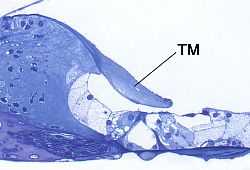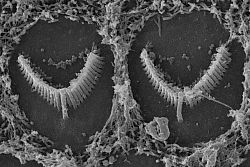Molecular and Cellular Basis of Hearing and Deafness
Our research is focussed on two structures within the cochlea, the tectorial membrane and the sensory hair bundle. The tectorial membrane is a ribbon-like strip of extracellular matrix that spirals along the length of the cochlea. It sits on top of the sensory hair cells and allows the sound-induced motions of the cochlear fluids to stimulate the hair bundles, collections of tiny finger-like processes that are found at the apical pole of each hair cell and generate an electrical signal when they are deflected. Mutations in many genes cause hereditary hearing loss. Some of these genes encode proteins that are found in the tectorial membrane and many of them encode proteins found within the hair bundle. We use a variety of molecular, genetic and cellular approaches to study how the tectorial membrane and the sensory hair bundle contribute to normal hearing and form during development, and how various mutations cause deafness. Certain commonly used antibiotics can cause hearing loss as an unwanted side effect and we are also studying how these compounds enter into and accumulate within the sensory hair cells of the inner ear thereby leading to hair cell death and deafness.
 Section of the cochlear showing the tectorial membrane (TM) sitting on top of the hair cells.
Section of the cochlear showing the tectorial membrane (TM) sitting on top of the hair cells.
 Scanning electron micrograph of cochlear hair bundles
Scanning electron micrograph of cochlear hair bundles


